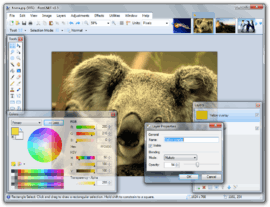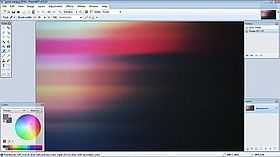Paint.NET
 | |
 Paint.NET version 3.5 | |
| Original author(s) | Rick Brewster |
|---|---|
| Developer(s) | dotPDN, LLC |
| Initial release | May 6, 2004 |
| Stable release | 3.5.11 (August 17, 2013) [±] |
| Preview release | v4.0 beta build 5152 (February 8, 2014) [±] |
| Written in | C#, C++ |
| Operating system |
Windows 8 Windows 7 Windows Vista with SP1 Windows XP with SP3[1] |
| Platform |
.NET Framework 4.0[2] .NET Framework 3.5 with Service Pack 1[1] |
| Size | 3.5 MB[1] |
| Available in | English, Chinese (Simplified), French, German, Italian, Japanese, Portuguese (Brazil), Russian, Spanish[1] |
| Type | Raster graphics editor |
| License | Freeware[3] |
| Website | www.getpaint.net |
| CPU | 800 MHz[1] |
|---|---|
| Memory | 512 MB[1] |
| Hard Drive Space | 200 MB[1] |
| Screen resolution | 1024×768 |
Paint.NET is a proprietary freeware raster graphics editor software for Microsoft Windows, developed on the .NET Framework. Paint.NET was originally created by Rick Brewster as a Washington State University student project,[4] and has evolved from a simple replacement for the Microsoft Paint program into a editor with support for layers, blending, transparency, and plugins.
Overview
Paint.NET is primarily programmed in the C# programming language. Its native image format, .PDN, is a compressed representation of the application's internal object format, which preserves layering and other information.[5] Excluding the installer, text, and graphics, Paint.NET was released under a modified version of the MIT License.[6] It was initially released as completely open source, but due to breaches of license, all resource files (such as interface text and icons) were released under a Creative Commons license forbidding modification, and the installer was made closed-source.[7]
Version 3.36 was initially released as partial open source, but the sources were later removed by Brewster, citing problems with plagiarism. In version 3.5, the license was altered to reflect this, and users are now prohibited from modifying the software. As free licenses cannot be revoked, developers can still legally develop forks based on version 3.36 and earlier. Brewster later stated that he hopes to release portions of the source code back into the public.
History
Paint.NET originated as a computer science senior design project during spring 2004 at Washington State University. Version 1.0 consisted of 36,000 lines of code and was written in fifteen weeks.[8] In contrast, version 3.35 has approximately 162,000 lines of code. The Paint.NET project continued over the summer and into the fall 2004 semester for both the version 1.1 and 2.0 releases.
Development continues with one developer who now works at Microsoft and worked on previous versions of Paint.NET while he was a student at WSU. As of May 2006 the program had been downloaded at least 2 million times,[9] at a rate of about 180,000 per month.[10]

Release history
| Version | Release date | Significant changes |
|---|---|---|
| 1.0 | May 6, 2004 | Initial release |
| 1.1 | October 1, 2004 | Support for effect plugins |
| 2.0 | December 17, 2004 | Many new effects, adjustments, and tools |
| 2.5 | November 26, 2005 | Internationalization support; update manager; support for file type plugins |
| 2.6 | February 24, 2006 | Use of .NET Framework 2.0, full 64-bit support |
| 2.72 | August 31, 2006 | Last version to support Windows 2000 |
| 3.0 | January 26, 2007 | This major release introduces a new multi-document interface (MDI), availability in 8 languages, a highly requested interactive gradient tool, four new effects, a user-definable color palette, lower disk space usage for scratch files, and a generally cleaner and improved user interface |
| 3.05 | March 29, 2007 | Added a new effect; improved certain parts of the user interface |
| 3.10 | August 23, 2007 | Two new effects added; support for the DDS filetype |
| 3.20 | December 12, 2007 | Enhancements to the built-in effects, a re-organized Effects menu, a new and much easier system for effect plugin development, better error handling for plugins, and the ability to draw Fixed Ratio and Fixed Size selections with the Rectangle Select tool. |
| 3.22 | January 12, 2008 | Adds a new Reduce Noise effect |
| 3.30 | April 10, 2008 | This release adds an Italian translation, a new "Fragment Blur" effect, and the ability to save PNG images at 8- and 24-bit color depths. For developers, the IndirectUI system has some new controls, some new constraint rules, and can now be used for file type plugins |
| 3.35 | June 7, 2008 | A new Posterize adjustment, a new Intersect selection mode, dramatically improved performance for selection editing |
| 3.5 | November 6, 2009 | Improved performance reliability, reducing memory usage, upgrading to the latest .NET Framework version, and refreshing the user interface for Aero and glass (Windows 7 / Vista) |
| 3.5.2 | January 4, 2010 | Resolves some feature disparities in the Text tool between GDI (Windows XP) and DirectWrite (Windows 7/Windows Vista). It also improves overall performance, as well as the correctness and quality of the Move Selected Pixels tool, the Image->Resize function, and the Hue/Saturation adjustment |
| 3.5.5 | April 26, 2010 | Fixes a bug when saving 8-bit images, improves layer composition and Gaussian Blur performance, and is updated to support the new .NET Framework 4.0 in some cases. Dropped support of Windows XP without Service Pack 3, additional support for .NET 4.0[2] |
| 3.5.11 | August 17, 2013 | Fixes the Gaussian Blur effect that was incorrectly calculating alpha values for non-opaque pixels. Effects Sharpen, Median, Fragment and Unfocus have seen an improved performance of 25%,30%,40% and 100% respectively. Also memory usage is reduced when many selection manipulation operations are in the history/undo stack. The built-in updater now supports upgrading to paint.net 4.0 (once it’s available) |
Plugins
Paint.NET supports plugins, which add image adjustments, effects, and support for additional file types. They can be programmed using any .NET programming language, though they are most commonly written in C#.[11] These are created by volunteer coders on the program's discussion board, the Paint.NET Forum. Though most are simply published via the discussion board, some have been included with a later release of the program. For instance, a DirectDraw Surface file type plugin, (originally by Dean Ashton) and an Ink Sketch and Soften Portrait effect (originally by David Issel) were added to Paint.NET in version 3.10.
Hundreds of plugins have been produced;[12] such as Shape3D, which renders a 2D drawing into a 3D shape. Some plugins expand on the functionality that comes with Paint.NET, such as Curves+ and Sharpen+, which extend the included tools Curves and Sharpen, respectively.
Examples of file type plugins include an Animated Cursor and Icon plugin and an Adobe Photoshop file format plugin.[12] Several of these plugins are based on existing open source software, such as a RAW plugin that uses dcraw and a PNG optimization plugin that uses OptiPNG.
Support for non-Windows operating systems
Paint.NET was created for Windows, and has no native support for any other system. With its previous open-source nature, however, the possibility for alternate versions was available. In May 2007, Miguel de Icaza officially started a porting project called paint-mono.[13] This project had partially ported Paint.NET 3.0 to Mono, an open-source implementation of the Common Language Infrastructure on which the .NET Framework is based. This allowed Paint.NET to be run on Mono-supported platforms, such as Linux. As of December 2010, this port is no longer maintained and hasn't been updated since March 2009.[14] There is also a project called Pinta which is described as a clone of Paint.NET for Mono and GTK+.
References
- ↑ 1.0 1.1 1.2 1.3 1.4 1.5 1.6 Brewster, Rick. "Paint.NET Download". dotPDN, LLC. Retrieved 28 November 2009.
- ↑ 2.0 2.1 Brewster, Rick. "Paint.NET v3.5.5 is now available". Paint.NET Blog. dotPDN, LLC. Retrieved 26 April 2010.
- ↑ Brewster, Rick (November 6, 2009). "A new license for Paint.NET v3.5". Paint.NET Blog. dotPDN LLC. Retrieved 2011-05-01.
- ↑ "Paint.NET - Free Software for Digital Photo Editing". Retrieved September 30, 2009. Bottom of the page, below about.
- ↑ "Paint.NET's file format, ".pdn"". Archived from the original on 2008-01-02.
- ↑ Paint.NET - Licensing and FAQ
- ↑ "Freeware Authors: Beware of "Backspaceware"". Paint.NET blog. December 4, 2007. Retrieved 2009-02-06.
- ↑ "Paint.NET v1.1 "Beta 2" Download". Archived from the original on 2007-12-21.
- ↑ "Paint.NET crosses 2 million downloads, and other news". Archived from the original on January 2, 2008. Retrieved June 16, 2006.
- ↑ "Interview: A Look Inside Paint.NET". Retrieved June 16, 2006.
- ↑ "CodeLab: Paint.NET Plugin Development Environment".
- ↑ 12.0 12.1 "Plugin Index".
- ↑ Paint Mono
- ↑
Further reading
- "Rick Brewster on Paint.NET" (MP3). .NET Rocks!. Franklins.net/PWOP Productions Inc. 17 April 2007. Retrieved 15 March 2011.
- Mook, Nate (27 February 2006). "Interview: A Look Inside Paint.NET". Betanews. Betanews, Inc. Retrieved 15 March 2011.
- "The Sharp Design Philosophy Behind Paint.NET". eWeek DevSource. Ziff Davis Enterprise Holdings Inc. 13 May 2005. Retrieved 15 March 2011.
- Sells, Chris (12 August 2005). "MSDN TV: Paint.NET - The .NET Framework in Action". Microsoft Download Center. Microsoft Corporation. Retrieved 15 March 2011. "Chris Sells interviews Rick Brewster, Tom Jackson, and Craig Taylor about their project, Paint.NET v2.1."
- How to install Paint.NET plugins "How to Install Paint.NET Plugins". BoltBait Dot Com. 2007. Retrieved 15 March 2011.
External links
| Wikibooks has more on the topic of: Paint.NET |
| ||||||||||||||||